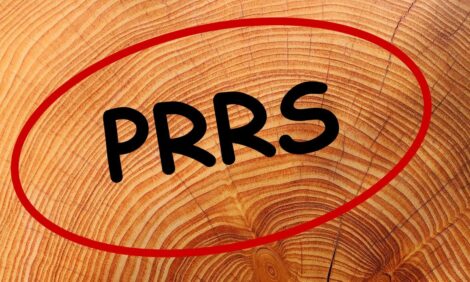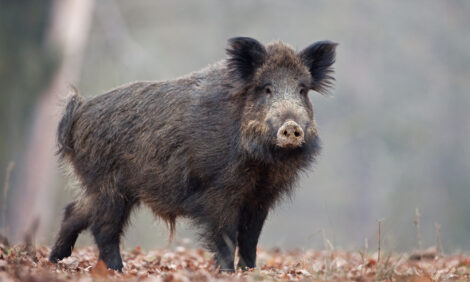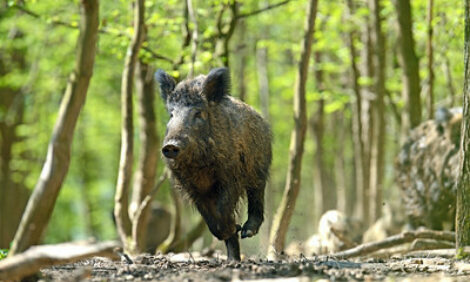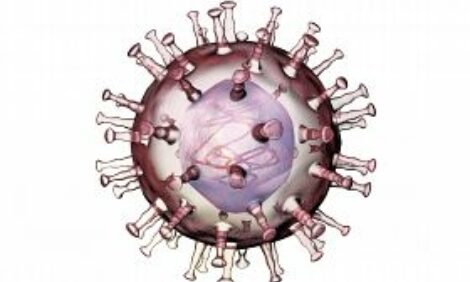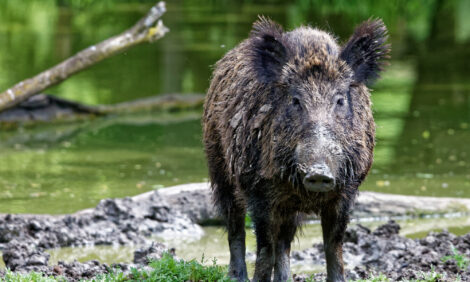



African swine fever in wild boar: biosecurity in affected forests
Learn about the effective and safe disposal of infectious wild boar carcassesEditor's note: the following is an excerpt from African swine fever in wild boar populations - ecology and biosecurity. It was created by the FAO, WOAH and European Commission. Additional content from the booklet will be shared as an article series.
African swine fever detection in free areas
Usually, ASF in wild boar in free areas is first detected in dead animals. Initially, a practical carcass management plan is rarely available, so the veterinary services should immediately lead the field operations. After the first detection, the infected area should be defined through an active search for carcasses. This search will help identify the geographic extent of ASF and allow for the designation of the infected area. The border of the infected area should follow the borders of the hunting ground involved as they will represent the main wild boar management units.
A general disposal strategy must be developed and should consider the availability of paved and unpaved roads to facilitate transport, soil characteristics (including texture, permeability, surface fragments, depth to the water table, depth to bedrock and hydrological properties) and proximity to water bodies, wells public areas, dwellings and residences. At the local level, the landscape of each hunting ground should also be considered to implement the strategy.
The personnel responsible for carcass disposal or transport must be trained on ASF and biosecurity. They must also be appropriately equipped with disposable clothes and overshoes or clothes and shoes that are easy to clean and disinfect. Involved personnel must not have any direct contact with healthy pigs for 48 hours.
Detection of wild boar carcasses
In the control and eradication of any animal diseases, the effective and safe disposal of infectious carcasses plays a crucial role. Safe disposal of carcasses is even more relevant for ASF due to their role in the epidemiology of the disease. Since early 2015, the role of carcasses has been highlighted and their detection and safe disposal is included on the list of the measures to control ASF in wild boar populations in the European Union (European Commission, 2018). The first step in detecting carcasses is to raise awareness among hunters and other stakeholders, particularly foresters and forest workers, and to include the general public. The awareness campaign should clearly address the procedure to be applied when finding a wild boar carcass.
Awareness campaigns should be carried out using all possible information modalities (e.g. face-to-face meetings, mass media, posters, leaflets, radio and TV shows). Different actors should be informed, including hunters and hunting associations, the general public
through municipalities and non-governmental organizations, veterinary practitioners, forest workers and forest management bodies, to increase the reporting of dead wild boar findings. Any individual who could potentially find a dead wild boar should know the basic rules on how to behave around the carcass:
- Do not touch the carcass.
- Ensure that the spot where the carcass has been found is visible or communicate exact coordinates of its location (any smartphone can be used).
- Inform the authority in change of carcass management, without delay.
Competent authorities must facilitate communication and never view reports of wild boar carcasses as a nuisance. In fact, those who report carcasses should be rewarded. The rapid detection and removal of contaminated carcasses is regarded as one of the pillars for the eradication of ASF in wild boar (EFSA, 2017).
It is well known that nothing is easier than ignoring a rotten, smelly wild boar carcass in a forest.
The availability of a free 24-hour phone line (green line) simplifies the collection of information, even when received from different areas of the country. Financial motivations for carcass reporting are one way to increase such reporting and a specific procedure should be developed in a country before ASF is detected. Several countries used to only reward hunters for reports, who would be paid through their official hunting associations.
Local hunters play a pivotal role in carcass detection as they are some of the main experts of the infected area. Following an ASF diagnosis in a wild boar population, hunters and foresters should actively search and regularly patrol the area, especially near wild boar resting and feeding areas, and natural or artificial water bodies (rivers, ponds, lakes). Sick wild boar usually hide in swamps or densely covered areas, where they can avoid disturbance.
Under normal conditions, even for hunted populations, natural mortality in wild boar is 10 percent of the population (Toïgo et al., 2008; Keuling et al., 2013). The reliability of the carcass reporting system, and therefore ASF detection, is measured through the number of dead wild boar reported in the absence of ASF. A desirable goal is to report 10 percent of carcasses that account for approximately 1 percent of the whole estimated wild boar population (i.e. ten reported dead wild boar out of 1 000 estimated wild boar indicates efficient passive surveillance).
Precautionary measures
Once an ASF-positive carcass is reported, there are several methods to dispose of it and thereby inactivate the virus. Countries are responsible for choosing which carcass disposal method to apply, and base their choice on factors such as local facilities, the environmental situation, constraints and costs.
Local burning or burying of carcasses must be authorized by competent authorities to prevent a negative impact on the environment. At the onset of the epidemic, the legal competence of each involved entity was often not clearly defined. Countries at high risk of ASF infections should therefore organize authorization protocols before the first case of ASF detection. The disposal of large numbers of wild boar carcasses poses both logistical and environmental problems, especially when carried out in mountains or wetland areas, and should be planned well in advance, particularly where the density of wild boar is high.
Countries at risk of ASF infection should define which service or agency is responsible for carcass collection and disposal. Veterinary, forestry or environmental services, municipalities or even local hunters and their associations could be made responsible. However, veterinary services should always be responsible for supervising carcass disposals and taking samples.
In each country, it is advisable to involve the forestry services and local hunters, including hunting clubs or associations, as fundamental partners in providing information and support during the collection and disposal of carcasses in the field.
Guberti, V., Khomenko, S., Masiulis, M. & Kerba S. 2022. Chapter 4. African swine fever in wild boar – Ecology and biosecurity. Second edition. FAO Animal Production and Health Manual No. 28. Rome, FAO, World Organisation for Animal Health and European Commission. https://doi.org/10.4060/cc0785





